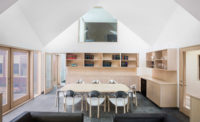How Is Coronavirus Affecting Architecture Firms?

Travelers wear face masks at the airport in Hong Kong. Photo © Studio Incendo
As the world reels from the onslaught of COVID-19, colloquially known as the coronavirus, the implications for the architecture profession are uncertain. To date, the World Health Organization reports more than 95,000 people have confirmed cases of coronavirus, resulting in more than 3,000 deaths. In China, where the outbreak has spread most widely, the government has placed whole cities under quarantine in an attempt to curb further contagion. Shifting travel policies—including outright flight stoppages into China and travel advisories for Italy, Iran, and South Korea—have slowed progress for many U.S. architecture firms doing business globally; some have shifted to video-conferencing to keep projects running as smoothly as possible in circumstances that are preventing many workers from going into their offices.
Yet in the face of these challenging conditions, James von Klemperer, FAIA, president and design principal with KPF, remains relatively optimistic, even with some 40 percent of the firm’s current work located in Asia, including four projects in Wuhan, the outbreak’s epicenter. So far, he says, KPF’s work continues: “We do have staff with relatives in Wuhan, a few of them actually being in the intensive care units in the hospitals. From a personal point of view, everybody in China is affected in one way or the other,” von Kemperer says. Despite the uncertain health situation, projects are pressing forward, even in the face of local government–mandated self-quarantine. Von Kemperer explains that teams are working in shifts: “We've split our offices into two platoons of 20 people each in Shanghai, and similarly in Hong Kong. And they each work for one week and then they shift to the other group. And the idea is, if anyone in the group is compromised by someone coming down with the virus, then the whole group within our office who have been working together would shut off and the next group would come on.”
Remote and virtual work has also facilitated continuity in many ongoing projects, even in locations not constrained by state-imposed quarantines. Several other international firms with work in China declined to comment for this story; one representative who preferred not to go on the record indicated that all travel to and from China has ceased, with that company switching to virtual meetings only as a precaution and wariness about the communicable nature of public transportation in affected areas. For those at KPF who are working from home, “We've instituted a rigorous system of reporting on work every day through work logs to give the staff and the operation a sense of well-being, that we're actually getting something done,” von Kemperer says. “And I think our clients appreciate this a great deal, because by and large, they are continuing the projects and continuing the practice, although in many cases they are dialing in from home themselves.”

While design and construction may continue, the coronavirus is taking its toll on travel-related trade shows, many of which are seeing delayed openings or cancellations, as RECORD has reported. Organizers for the Salone de Mobile in Milan announced a four-month postponement “in view of the ongoing public health emergency,” pushing the furniture trade show’s opening to June 16 as Italy faces its own mounting health crisis. Likewise, design events in China and elsewhere have been postponed—including Design Shanghai, which moves to May—or canceled outright, as with this year’s edition of Art Basel Hong Kong.
For their part, Chinese construction workers—many adding face masks to their personal protective equipment—completed a 1,000-bed hospital in the city of Wuhan in just 10 days, highlighting the efficacy of a workforce that can be mobilized in exigent circumstances, as was the case in 2003 with the outbreak of SARS. How non-medical construction will continue as increasing numbers of essential workers become homebound remains to be seen.




